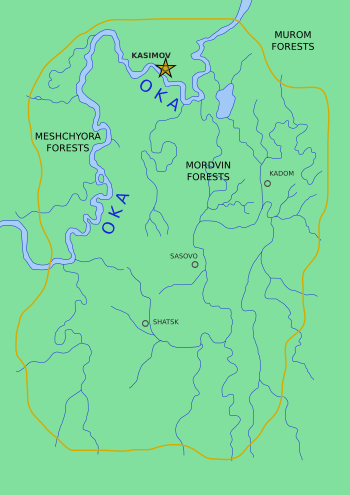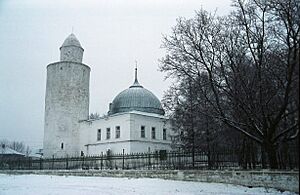Qasim Khanate facts for kids
Quick facts for kids
Qasim Khanate
|
|||||||
|---|---|---|---|---|---|---|---|
| 1452–1681 | |||||||

Map of the Qasim Khanate
|
|||||||
| Status | Vassal state of Russia | ||||||
| Capital | Kasimov | ||||||
| Khan | |||||||
|
• 1452–1469
|
Qasim Khan | ||||||
| Historical era | early modern period | ||||||
|
• Established
|
1452 | ||||||
|
• Disestablished
|
1681 | ||||||
|
|||||||
The Qasim Khanate was a special kingdom ruled by Tatar people. It existed from 1452 to 1681 in what is now Ryazan Oblast in Russia. Its capital city was Kasimov, located near the Oka River. This khanate was a "vassal state" of Russia, which means it was like a smaller kingdom that was loyal to and protected by a bigger, more powerful one.
The Qasim Khanate was created when Grand Prince Vasily II of Moscow gave land to a Kazan prince named Qasim khan in 1452. Qasim Khan was the son of the first Kazan khan, Olug Moxammat.
Contents
How the Qasim Khanate Began
Before the Qasim Khanate, the land was home to different groups of people. These included the Finnic tribes called Meshchyora and Muroma, and the Mordvins. This area was influenced by early Russian states like Kievan Rus' and the Volga Bulgaria kingdom.
Later, the land became part of a larger Russian area called Vladimir-Suzdal. In 1152, Duke Yuri Dolgoruky founded a town called Gorodets-Meshchyorskiy, which is now Kasimov.
After the Mongol armies conquered many lands, this territory became part of the huge Golden Horde. Turkic people settled here, and many of them became Muslims because of the influence from the Volga Bulgars. A small, almost independent area called Mishar Yurt was also formed by a Mongol leader.
From 1393, the area became part of Muscovy, which was the start of modern Russia. However, after a big battle in 1445, a Tatar leader named Olug Moxammad wanted these lands back for the Tatars.
Some historians believe that the Russian ruler Vasily II agreed to this. He crowned Olug Moxammad's son, Qasim, as the ruler of the Meshchyora lands. The area and its capital city were then renamed after him. Another idea is that Qasim started working for the Russians. He was given these lands to create a "buffer state." A buffer state is like a protective zone between two bigger powers, in this case, Grand Duchy of Moscow and the Khanate of Kazan.
Even though the Qasim Khanate had its own rulers, Russia controlled its foreign policy. This means Russia decided how the Qasim Khanate would deal with other countries.
Who Lived in the Khanate?
The land was mainly lived in by Mordvins. Some of them, along with other Finnic groups like Meshchyora and Muroma, slowly became part of the Tatars. These people are now known as Mishar Tatars. Later, more Russians also settled in the area.
Some Kazan Tatars moved to the Qasim lands and were called Qasim Tatars. Most Qasim Tatars worked in the khan's palace or served in the khan's army. Over time, this group also blended with the Mishar Tatars. However, about 1,000 Qasim Tatars still live in the city of Kasimov today.
The important noble families in the khanate were the Manghyt, Arghyn, Jalair, and Qipchaq. The Russian leaders in Moscow chose the khans from the ruling families of other Tatar khanates, such as the Khanate of Kazan, the Crimean Khanate, and the Siberia Khanate.
Key Moments in Qasim Khanate History
The Qasim khans and their soldiers often helped Moscow in its attacks on Kazan. They took part in campaigns in 1467–1469, 1487, and 1552. One Qasim khan, Şahğäli (who lived from 1515 to 1567), was even crowned as the Kazan khan three times with help from Muscovy.
After Russia conquered Kazan, the Qasim Khanate lost some of its self-government. Russian governors, called voyevodas, started to manage the khanate. However, khans still officially ruled.
One interesting khan was Simeon Bekbulatovich. He became a Christian and was even declared the Grand Duke of Moscow in 1574. But he never truly ruled. He was used by the Russian Tsar Ivan the Terrible as a temporary, puppet leader.
During the rule of Sayed Borhan khan (1627–1679), Russia began a policy of "Christianization." This meant they encouraged people to become Christian. The noble families, called Begs, who were like Russian Boyars, had their status changed. They became "Serving Tatars," which was a lower rank. This policy caused a Tatar revolt in 1656.
The Qasim Khanate officially ended in 1681, after the death of the queen, Fatima Soltan.
See also
 In Spanish: Kanato de Qasim para niños
In Spanish: Kanato de Qasim para niños


